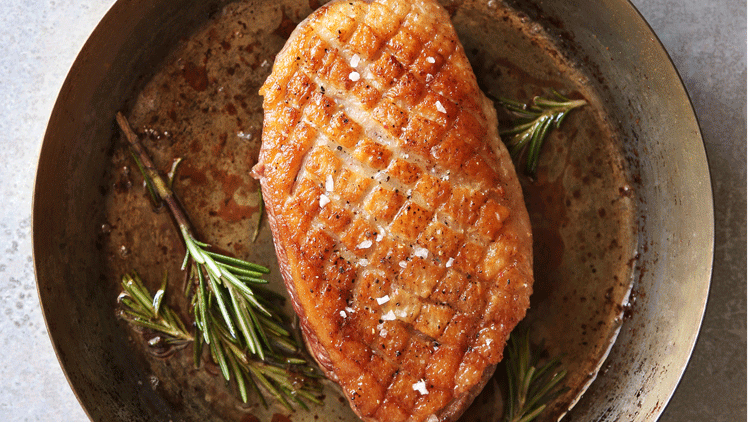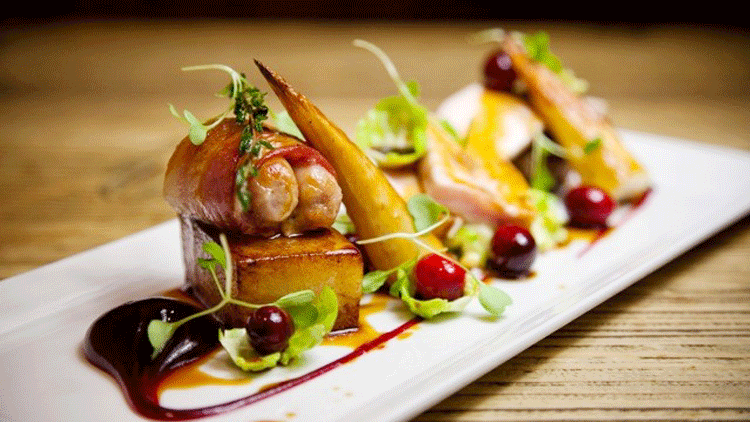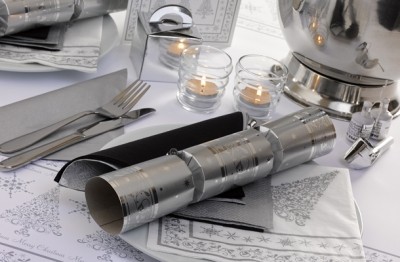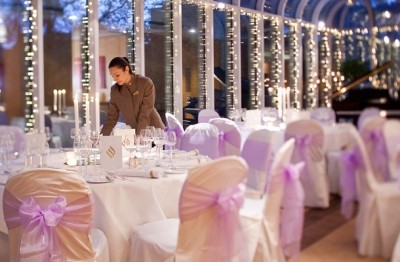To turkey or not to turkey: what meat is best for Christmas menus?
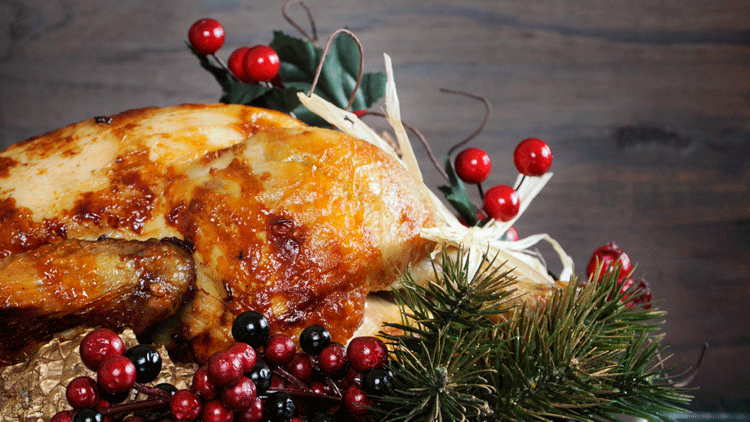
Not putting turkey on a Christmas menu is “suicidal”, says Stosie Madi, chef at The Parkers Arms in Newton in Bowland, Lancashire. You might infer from that, therefore, that the traditional Christmas bird takes pride of the place on the menu at the award-winning contemporary country inn over the festive season. But you’d be wrong.
Madi is one of many chefs who choose to eschew turkey at Christmas. But not for flavour reasons or because she doesn’t like the bird but because she instead chooses to take advantage of the large amount of game available on her doorstep throughout the festive period.
“We decided after the first two years of opening that we would not go down the route of cooking any sort of cut not available to us within a few miles of the pub during the Christmas season,” says Madi. “Because we use game from September right through to the end of January we find our costs are quite low and we’ve educated our clientele to eat it. While everywhere else is serving turkey, it’s nice to do something different. We want to keep it traditional but not that traditional.”
She admits that she has had to work hard to educate people that The Parkers Arms is a turkey-free zone over Christmas, but insists the challenges that come with a rural pub serving turkey are far greater than having to explain to customers why it’s not on the menu. “Years ago we put turkey on the menu but it was a killer,” she says.
“We had lots of Christmas parties that took up all our seats and we had to employ extra staff to cover it, which now costs even more than ever. We can’t put on a service charge as people don’t want to pay it, they don’t leave a tip and they don’t even drink because they have to drive here. If we could make money on drink we might do a more traditional Christmas party menu but we can’t so we have had to adapt to make us stand out from the crowd.”
Avoiding dishes because they might prove too popular might sound counter-intuitive but Madi says she’d rather use ingredients that offer much greater GP and which she can source easily. In the case of The Parkers Arms, this is game such as mallard, pheasant, and venison, which she buys in whole and butchers on site.
Madi says she can get her hands on a whole carcass of roe or muntjac deer for around £50 – red or sika deer is considerably more – and wild ducks for around 50p a bird. “If you take a whole animal in fur or feather and process it down you cut out the middle man,” she says.
“A duck breast would cost me about £4 each so when you add other garnishes you’re looking at a minimum price of around £8 for a dish, which is a lot, and we can’t afford to give half portions because we’re a pub and people expect a certain portion size. But I can get a brace of whole ducks for a pound. It just takes time to pluck and butcher them.”
Out for a duck: mallard is a great and more grown-up alternative to turkey
Nothing is wasted. As well as using the breasts, Madi confits the legs, which she serves with home-made pancakes as a starter. The livers are used to make parfaits, which are served throughout the festive period – “they basically come free with the bird,” she says – and the hearts are cooked on skewers and flavoured with Middle Eastern spices. “For a pound a brace you can’t go wrong really. It’s the bird that keeps on giving. And smoked or cured duck breast also lend themselves to the Christmas festivities.”
With the venison, Madi uses the expensive loin cut in her starters because she says she can use less of it and add fewer garnishes to keep her costs down and her GP up. She seams out the haunches, which she cooks like a saddle of lamb. The legs, meanwhile, are used to make braises and pies. “We can demand top dollar while keeping costs to a bare minimum,” she says.
For those wanting a similar experience to turkey, Madi instead has pheasant on the menu, which she makes into a ballotine and serves throughout the festive season with sherry gravy and a local relish. “People often say they don’t like game because it’s got a very strong flavour but we don’t hang it. We cook it pretty much within hours of it being shot, which gives it a much better texture. It’s not as pappy as farmed chicken.”
The pro-turkey camp
Steven Smith, chef proprietor at Freemasons at Wiswell in Lancashire’s Ribble Valley, also believes in Madi’s ‘traditional but not that traditional’ approach to Christmas menus. Already fully booked for Christmas day, Freemasons at Wiswell does have turkey on the menu, something that Smith is unapologetic about, but he ensures there’s plenty of other less obvious items too.
“It’s a fine balance between the tradition and the modern – people do want to eat turkey and Christmas pudding,” says Smith. “The Christmas period is the only time that people want to eat turkey and a lot of chefs get that wrong and say ‘I’m not bloody cooking turkey’. It’s important to keep things familiar for the average diner. You’ve got to run a business and appeal to a broader section than just the foodie and put familiar things on the menu – but you can still innovate with them.
“I’ve known people come and have turkey 10 times during December – but they won’t eat it at any other time in the year. From a business point of view it makes sense to cook it.”
With the turkey, for example, Smith doesn’t roast whole birds but instead creates individual portions of turkey breast roll which he first poaches in a water bath at 58°C.
“It’s much better than roasting a big joint and it being inconsistent and someone getting a dry bit. Everyone gets their own individual portion. We’ve got the consistency and execution we want, but it’s still roast turkey at the end of the day and we still serve it with pigs in blankets and sage and onion stuffing. It’s traditional but a lot of extra work has gone into it in the background.”
Bath time: Steven Smith cooks his turkey breast sous vide
While Smith says that turkey or prime cuts of beef are the favoured choices come the big day, during the run up to Christmas customers are willing to choose other things, and he takes the opportunity to create interesting dishes that offer high GP. One such dish is his version of gammon and eggs, featuring pressed ham hock, a slow cooked egg and pineapple. Smith puts the ham stock in a centrifuge and clarifies it until it is crystal clear to create what he describes as a gammon dashi, which is then poured at the table.
“During Christmas when we’re very busy this is a dish that we can execute time and again,” he says. “Ham stock is something people would throw away, but it’s free. A lot of effort goes into the dish, but there’s not a lot of food costs.”
Rising meat prices have also encouraged Smith to look at cheaper cuts to help with margins. Freemasons has featherblade of beef on the menu throughout the whole of December, which is braised in Guinness and local ales, although he says the beef option switches to a 60-day aged sirloin come Christmas Day. He also balances more expensive cuts with cheaper ones.
“When you get to Christmas Day people expect the finer things such as lobster and beef, But it’s a balancing act. I like to use premium cuts with a braised cut, so a loin of lamb could be balanced out with some minced lamb shoulder on a dish. It’s posh and poor.”
This is an approach championed by Simon Smith, director of customer relations at butcher Aubrey Allen. Smith also suggest pairing different cuts to use the whole animal carcass and to keep costs down. For example, he suggests slow cooking turkey legs to create pulled turkey that can then be served alongside a smaller portion of breast meat. The same can be done with shoulder of venison, he says, which can also be used in casseroles.
Aubrey Allen’s Smith is also an advocate of Steven Smith’s use of gammon on his festive menu. “Maple cured rib eye of pork or bacon are underused cuts of meat but are really fantastic,” he says. “They are cost-effective cuts and taste delicious.”
Cooking between the celebrations
It’s not just the run up to Christmas Day that chefs need to be on top of, however. The time between Christmas Day and New Year’s Eve provides yet another opportunity to bring in the diners who may be avoiding cooking for themselves, or looking to get a break from the family routine – but chefs need to be smart, advises Freemasons’ Smith.
He believes that in this short period people will actively avoid any festive food, which is why he puts on themed meals instead. This year he will run a New York day, with dishes including lobster rolls, hot dogs, and steak and mash with A1 sauce and is once again having a taco night, with five different tacos – pork belly, blood sausage, kimchi, beef bourguignon and tandoori monkfish – on the menu. “We did 100 people last year,” he says. “We could have done 300. It’s a change of pace before we get back to the five-course tasting menus of New Year’s Eve.”
Smith at Aubrey Allen suggest that kitchens should consider dishes that are easy to hold and prepare to manage unpredictable custom and staffing issues. “Lots of places reduce staff directly after Christmas day and restaurants are often not sure what numbers they might do so think about dishes that can be made sous vide,” he says. He suggests cuts such as pigs cheek or ox cheek – the latter being described as daube of beef on a menu – being suitable for this purpose.
And what of any surplus turkey a restaurant might have? While turkey curry might be the mainstay of a household four days after Christmas Day, it’s unlikely to be the go-to dish in a restaurant given the leftover connotation of the dish. An option can be found in the dish Madi would prepare if turkey was a prerequisite at The Parkers Arms: escalope Milanese.
“You get the most money from this cut,” she says. “Everybody likes something fried and in breadcrumbs. I’d serve it with a nice chutney with goose fat potatoes and the trimmings, such as a very nice Brussels sprout salad. It’s an accessible thing to eat, and it’s good drinking food.” Wise words indeed.
